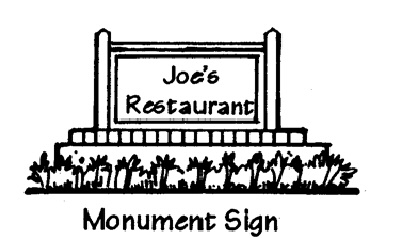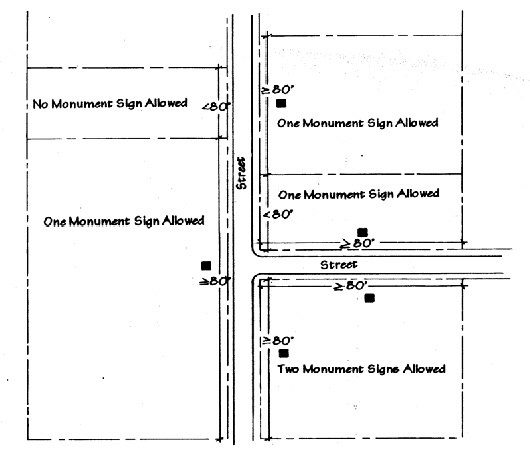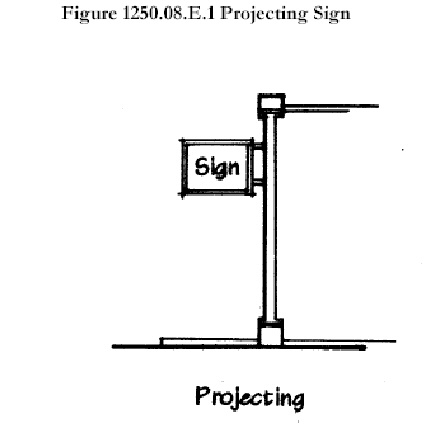1250.08 REGULATIONS BY SIGN TYPE.
A. Regulations Affecting Wall Signs.
1. Purpose. The purpose of a wall sign is for identification.
2. Size. The maximum area of wall signs along the frontage of a single business enterprise shall be equal to one (1) square foot of signage for each one (1) lineal foot of building frontage, but shall not exceed fifty (50) square feet nor any greater limitation established in this Chapter. Corner lots may be permitted up to two (2) signs, if each is facing a major street. Each frontage shall be permitted one (1) square foot of signage for each one (1) lineal foot of building frontage, up to a maximum of fifty (50) square feet.
3. Location. Permitted wall signs shall be located and designed subject to the following criteria:
a. Location on Building Facade. A wall sign cannot be located above the cornice line or second floor window line of a building, whichever is lower.
b. Street Frontage Orientation. All wall signs shall be oriented to face the street by being mounted on the building facade generally parallel or perpendicular to the street. Where a property is located on a corner lot, signs may be provided on both streets.
c. Dual Street Frontage Orientation. When a building on a corner lot has a facade which is oriented to the corner, a wall sign may be placed on two (2) of the three (3) façades as illustrated below.
 |
4. Projection. A wall sign shall project no further than twelve (12) inches from the wall on which it is mounted.
B. Regulations Affecting Monument Signs.
1. Purpose. The purpose of a monument sign is identification from a sign on the ground.
Figure 1250.07.B.1 Monument Sign
 |
2. Frontage Requirement. No activity may display a monument sign oriented to any street or highway unless the activity has not less than eighty (80) feet of frontage at grade along such street or highway.
Figure 1250.08.B.2 Frontage Requirement for Monument Signs
 |
3. Signable Area.
a. A monument sign may display not more than two (2) signable areas, located on opposite faces of the sign.
b. The maximum permissible area of each single sign face shall not exceed twenty-four (24) square feet.
4. Height. Monument signs shall not exceed five (5) feet in height. Such height includes one (1) foot to be used for the base of the sign.
5. Location.
a. Monument signs shall be located no closer than five (5) feet from the front property line no closer than ten (10) feet to the principal structure and no closer than ten (10) feet to the driveway.
b. The monument sign shall be located outside the visibility triangle established in Section 1260.05, View Obstructions, of this Zoning Ordinance.
c. In determining the appropriate location of a monument sign along the property frontage, a minimum separation of eighty (80) feet from other monument signs shall be maintained.
6. Landscaping. The base of monument signs shall be located in and softened with mostly evergreen landscaping in an amount to be determined by the Zoning Administrator.
7. Special Conditions Affecting Places of Worship. Monument signs for places of worship may incorporate changeable copy. The monument sign must be set back at least twenty-five (25) feet from the adjoining side lot line and front property line or right-of-way.
C. Regulations Affecting Window Signs.
1. Window Signs as a Primary Sign.
a. Upper Story Businesses. Businesses whose only windows are above the first story of a building may display one (1) permanent window sign in one (1) window. The lettering of such sign shall not exceed four (4) inches in height .
b. Ground Floor Businesses. A ground-floor business may display, as its primary sign, one (1) permanent window sign per business, either with or without a separate entry door. Such signs shall be limited in area to one (1) square foot for each lineal foot of building frontage, not to exceed fifty (50) square feet or any greater limitation of this Chapter.
2. Window Signs as a Secondary Sign. Ground floor businesses may also display a window sign as a secondary signs. The placement and design of window signs shall, in addition to all other requirements of this Chapter, be subject to the following:
a. Location of Permanent Window Signs. A permanent window sign must be located on the window and be contained totally within a single window. A sign will also be considered as a window sign if it is located within six (6) feet inside the window.
b. Total Area of Permanent Window Signs. Permanent window signs cannot exceed fifteen percent (15%) of the area of the window through which the sign may be seen or six (6) square feet, whichever is less.
c. Total Area of Temporary Window Signs. A person may display one (1) or more temporary window signs on each window of the premises, but the total area of all window signs in any one (1) window shall not exceed ten percent (10%) of the area of that window. Such temporary window signs shall be displayed for no longer than thirty (30) days, pursuant to Section 1250.04.B.6, Temporary Window Signs.
d. Total Area of All Window Signs. The combined total area of Temporary and Permanent Window Signs shall not exceed twenty percent (20%) of the area of the window through which such signs may be seen.
e. Computation of Coverage. Window panels separated only by mullions shall be considered as one (1) continuous windowpane in the computation of window surface area.
f. Transparency of Sign. Permanent window signs shall be “see-through” with a transparent background.
g. Window Displays. Window displays shall be limited to forty percent (40%) of the window area. No window display located within six (6) feet of the window may be maintained which has the effect of circumventing the intent of this Section 1250.08.C.2, Window Signs as a Secondary Sign. If material purporting to be a window display has such effect, it shall be deemed to be a temporary window sign and not a window display.
D. Regulations Affecting Canopy and Awning Signs.
1. Relationship to Wall Signs. Canopies and awnings may constitute an activity’s primary sign unless an activity displays an identification sign installed as a wall or window sign. However, any activity located in a commercial district may display edge lettering on a canopy or awning as a secondary sign in accordance with the provisions of this section.
2. Coverage Limitations.
a. If canopies and awnings are used to display a primary identification sign, the area of such sign may not exceed twenty-five percent (25%) of the surface of the canopy or awning or six (6) square feet, whichever is less.
b. If canopies and awnings are used as a secondary sign, lettering may be placed on the edge of a canopy or awning hanging perpendicular to the street if the lettering is nine (9) inches or less in height.
3. Location Requirements.
a. No portion of a canopy or awning shall be less than eight and one-half (8 1/2) feet above the level of the sidewalk or other public thoroughfare over which it projects.
b. No portion of a canopy or awning may extend more than five (5) feet from the building facade.
c. No portion of a canopy or awning may be located within the public right-of-way.
4. Additional Review Required. The location, design, and installation of canopies and awnings is subject to the approval of the Architectural Board of Review and the Building Commissioner.
E. Regulations Affecting Projecting Signs.
1. Limited to Use in Local Sign District Regulation. A projecting sign may only be authorized as part of an approved local sign district plan, subject to the procedures and requirements of Section 1250.09, Local Sign District Regulations. A projecting sign may be used only as a secondary sign. Any other use of a projecting sign is prohibited.
 |
2. Cannot Project Above Cornice. No element of an approved projecting sign, including any support structure or cables, shall extend above the cornice line of the building to which it is attached.
3. Location and Spacing of Projecting Signs. The location of a projecting sign and its spacing in relation to any other sign shall be established by the City Planning Commission as part of a Local Sign District plan, and approved as special regulation by the Architectural Board of Review.
4. Maximum Projection of Projecting Signs. Projecting signs shall extend no more than three (3) feet from the facade of the building except as otherwise regulated by the Local Sign District.
5. Maximum Area of Projecting Signs. The maximum area of projecting signs shall be no more than six (6) square feet except as otherwise regulated by the Local Sign District.